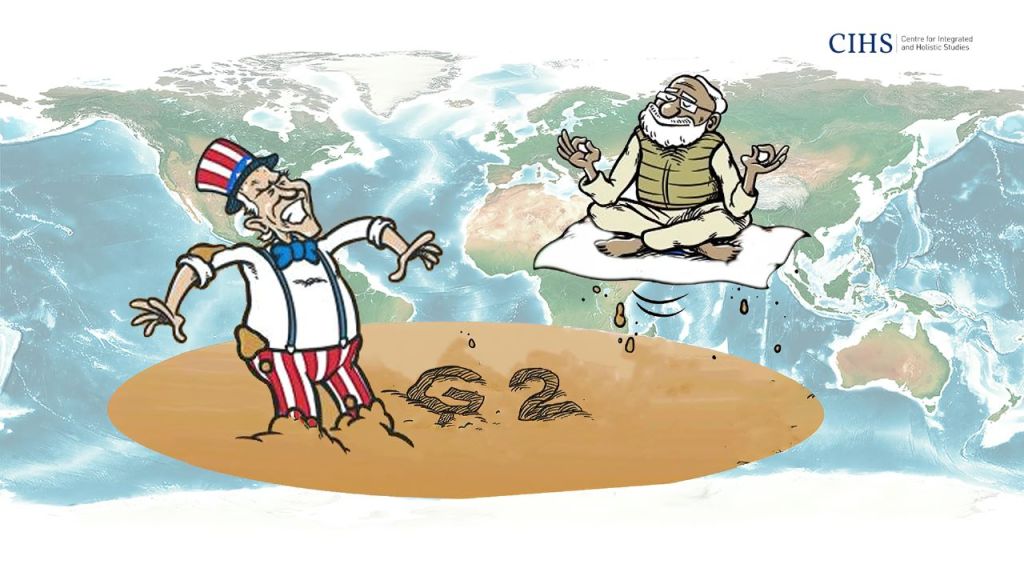G-2 – US and India – super power grouping may not work for either side. Emerging and critical tech at fulcrum of bilateral engagement
K.A.Badarinath
The very talk of stitching up G-2 super power group between US and India during Prime Minister Narendra Modi’s state visit is rather an unforgettable moment.
In a fluid global situation, whether G-2 would finally be reality or not is something for geo-strategic experts to analyse, separate grain from chaff and derive the implications.

US press has been abuzz with possibility of President Joe Biden ably assisted by secretary of state Jake Sullivan to bring focus to the idea of G-2 – US and India – forming a super power group.
This is akin to what was talked about in early ‘80s by the US security establishment that attempted such a grand grouping with the then reluctant and recalcitrant China.
Later, there were reports that President Barack Obama had revived this G-2 grouping with China when Hu Jintao was the powerful general secretary of Chinese Communist Party and country’s President.
This grand idea of US – China group gained popularity after two major think tanks, Center for Strategic and International Studies and the Peterson Institute for International Economics had revived the conversation in 2011.
Pomp and show that surrounds Prime Minister Modi’s visit as globally most popular leader, forming a G-2 – US and India – is something that needs deeper understanding and analysis.
US, world’s largest economic power and strategic powerhouse thinking of India as a G-2 ally is elating. Jack Sullivan is reported to be harbinger of this idea, if at all it works for both sides.
As G-2, identifying common rivals, partners and competitors, may not after all be a good idea for both US and India in an ever evolving world order.
From US perspective, depending heavily on its allies like Japan, Australia and India to checkmate China in Asia theatre and elsewhere including Asia Pacific is a calculative move. At the same time, complete breakdown of relations between China and US is not a feasible preposition. In fact, this complex security matrix explains why democratic white house under President Joe Biden is interfacing with all the three – Japan, India and China – this week to finalize its Asia strategy.
US being a great ‘strategic ally’, the first to go to, may continue to work for India. That does not allow Indian foreign affairs establishment under Subrahmanyam Jaishankar to shed the ‘independent policy’ stance that has come to smart focus in recent past.
India’s independent policy stance gained credence for New Delhi’s stand on Russia – Ukraine conflict, Covid-19 management, multi-faceted engagement as G-20 President. Not becoming part of a military alliance has been stated policy of India and there’s little or no scope for a change in this stance. It’s in this backdrop that India not joining NATO forces should be viewed notwithstanding the standing invitation from US.
In the Russia – European Union standoff, India refused to side with one group or the other unlike China and US taking respective sides. As G-20 President, batting for African Union’s full membership speaks volumes.
At the same time, engaging with Shanghai Cooperation Organization and Quad with equanimity brought was recognized by world powers as a responsible way for the 1.4 billion strong India as the largest growing economy for two consecutive years and hat trick to be hit.
In this backdrop, emerging and critical technologies, removing export controls on transfer of this knowhow by US to its most trusted partner India could be the starting point to taking bilateral relations one notch above.
Artificial intelligence, quantum computing, space, semi-conductors, dedicated telecom infrastructure for strategic heft, biotechnology, aerospace are among areas where export controls may have to be lifted and shared with India.
For instance, buying ‘predator’ drones to enhance surveillance and ‘jet engines’ must make technology transfer integral to the two governments level defence deal. Refurbishing and servicing the US Naval ships in India should become more of a common practice rather than one off events.
Areas like education, affordable healthcare, vaccines, medicines; solar energy and green hydrogen as well as joint defence production deals can be the next big step for the two large democracies that are open, flexible and transparent in their relations.
Independence in foreign policy engagement at bilateral level and multi-lateral issues is something that India takes pride in. And, this independence in policy will have to be assiduously protected, cherished and propagated for India to play a larger, responsible and compassionate power to reckon with.
Smartness with soft power image of India goes well to realize her dreams of ‘Vasudaiva Kutumbakam’, world as ‘one big happy family’ that’s humane.
(Author is Director and Chief Executive, Centre for Integrated and Holistic Studies, non-partisan think tank based in New Delhi)
